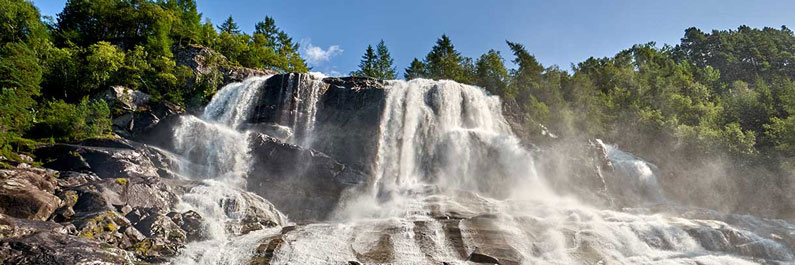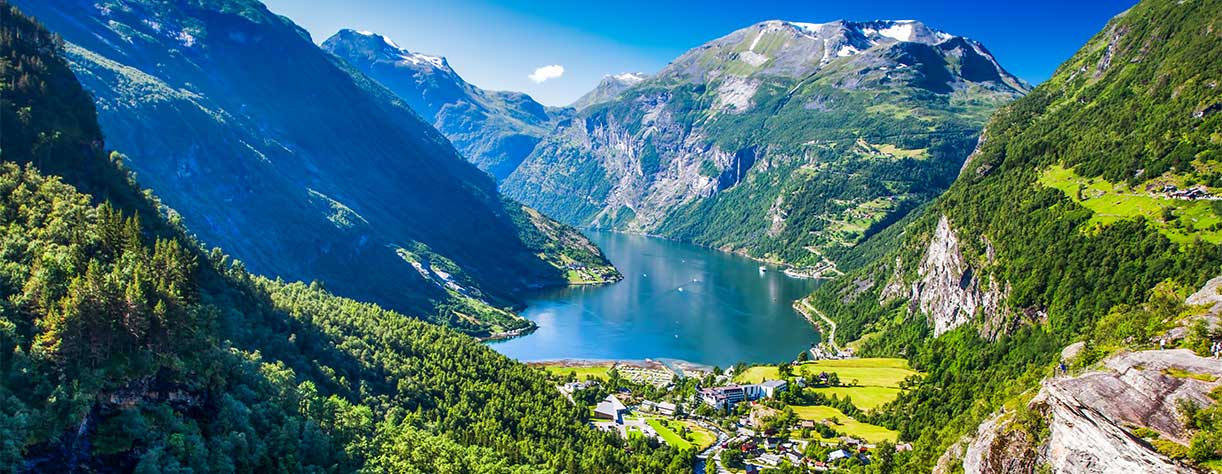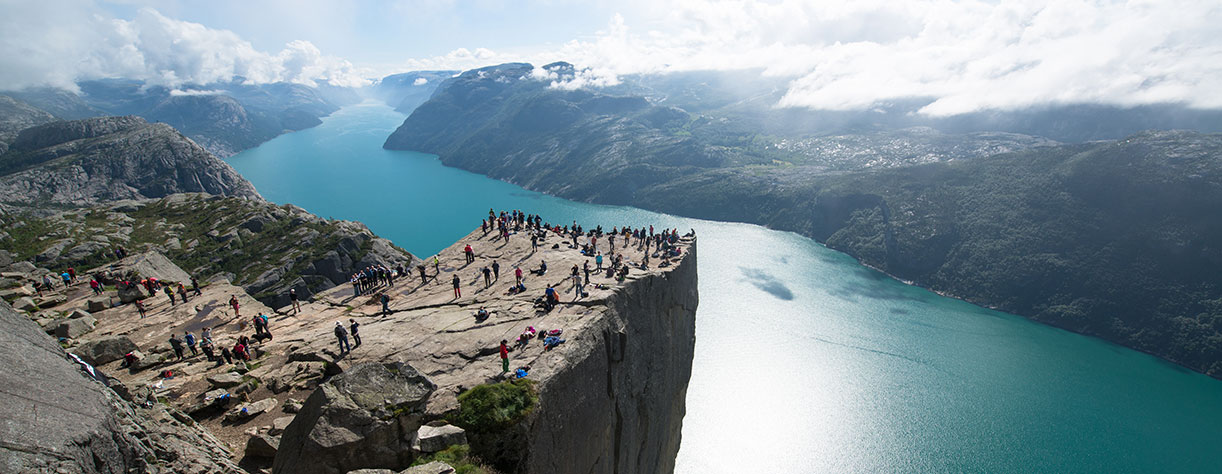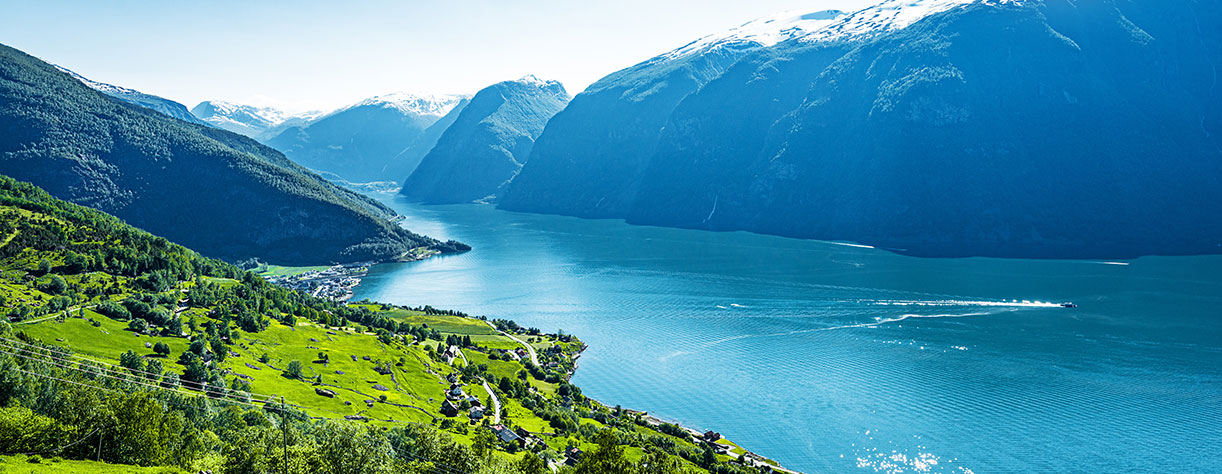When you gaze at the dramatic Norwegian mountain landscapes from the deck of a Fred. Olsen cruise ship, one question springs to mind: what on earth gave the Vikings such an unquenchable wanderlust? A thousand years later, the landscapes are no less breathtaking and are undeniably one of the most spectacular natural wonders of the world. Let's take a peek at some of the highlights you can take in on your visit.
Lofoten – the village by the icy sea
Next time you're within reach of a globe, spin it around to find Norway, trace the coastline just as it starts to curve westward, and you'll see an outcrop of islands. You've just found Lofoten, at 68 degrees North, and it’s one of Norway's most stunning natural spectacles. It's an archipelago and district that's home to about 25,000 Norwegians, so it’s nowhere near as remote as it might look, despite being in the Arctic Circle. These intrepid people are used to long summer days and endless winter nights, and the enigmatic presence of Northern Lights which naturally spellbind any visitor who sees them for the first time.
Amazingly, there's a road, with 13 bridges and a tunnel, that leads all the way from mainland Norway to the southwestern tip of the archipelago. There, you'll find a little fishing village called Å, which is much easier to spell than most Norwegian settlements (the name means "stream").
It's impossible to pick a highlight from this stunning landscape; but there is no greater endorsement than the fact that Norwegians from Oslo and Bergen, who are not unaccustomed to natural beauty themselves, like to marvel at Lofoten on their own holidays.
However, there's one picture postcard scene that will crop up in any account of Lofoten that we simply have to mention. It's the village of Hamnøy, just up the road from Å. It's like something out of a fairy tale, especially after a dusting of winter snow and after dark when the lights come on, in and around the cabins. Watched over by Olstinden, a 675m (2214 ft) mountain that emerges from the sea, it's a sight you'll carry with you forever.
Geirangerfjord – a wonder of the natural world
Located about 200km North East of Bergen, Geirangerfjord (also known as The Geiranger Fjord) is a major attraction in Norway, and a UNESCO World Heritage Site. Although 50km inland, it's still connected directly to the sea via the Sunnylvsfjorden, which branches off the Storfjorden (Great Fjord). It's named after the village of Geiranger (population 250) that's located at the inland end of the fjord.
Just like Lofoten, it's natural beauty acts as a magnet to visitors from all over the world, and many from Norway. It's a real place of contrast between summer and winter. In the summer months it's a lush green territory, with temperatures reaching about 19°C on a good day. At this time, Geirangerfjord fills with hikers and sightseers taking in the craggy vertiginous Norway mountains, and it's one of the few places where you can walk behind a waterfall.
In fact, if you love a waterfall from any angle, this is your place. There are plenty to observe including the beautiful Seven Sisters Waterfall. Although it's 410m high (think The Shard with Big Ben perched on top), it's still only the 39th tallest in Norway.
In the winter, it is, as you might expect, a crystalline white wonderland. The snow and ice cover everything but the most vertical surfaces, and visitors will spend hours captivated by the scale and beauty of the Norway mountains and falls in every direction.
A bit of trivia you might enjoy before you visit is that a fjord is technically an inlet from the sea rather than an estuary, but fresh water does flow from rivers into them, especially during the summer. This tends to make a fjord saltier than a river but fresher than the sea, but they all come with their own characteristics. And, although the word "fjord" comes from Norwegian, it's the name given to the geographic feature that can be found wherever glaciers have melted, in the northern and southern hemispheres, such as, for example, the Garibaldi fjord in Chile.
Preikestolen – the Pulpit Rock
There's mystery and myth surrounding this almost perfectly square, perfectly flat granite platform atop a 604m drop to the Lysefjorden fjord below. That is unless you're a geologist, in which case you can explain clearly how a glacier can, over thousands of years, construct something so hauntingly human-made that it is a place of pilgrimage for 200,000 beauty seekers each year. This wonder is located in the south west of Norway.
Preikestolen translates loosely as "Pulpit Rock" or "Preacher's Chair", although we don't know what the Vikings called it – the current name was coined as recently as 1900. It has to be seen to be believed, and there's a walk from base camp that takes about four hours to complete, after which you can head into the village of Jørpeland for some magnificent food.
Sognefjord, the King of Fjords
As you might have guessed from the nickname, Sognefjord is Norway's longest and deepest fjord, stretching more than 200km in length. It joins the North Sea about 80km north of Bergen and acts as a kind of trunk to dozens of smaller (but no less impressive) fjords that branch off it. It's so enormous, it dwarfs Fred. Olsen's smaller sized cruise ships, but cruising Sognefjord is perhaps the best way to see the Norwegian fjords, with their sheer slopes and snow-capped peaks. Such scenery can’t be found anywhere else in the world, and with the comforts on board the ship, it's hard to think of a more blissful way to spend a week or two on the water.
Further delights await on a Norwegian cruise
People cruise the seas and fjords of Norway for a simple reason – a deep love of dramatic scenery combined with the joyous atmosphere on board. You can cruise deep into the country on a trip to see the UNESCO site at Naeroyfjord, on the Scenic Summertime Waterfalls cruise.
A little further north on the coast, there's a cluster of gems in a relatively small area, mixing the man-made and — as myth and legend would have you believe — the troll-made. The famous Trollveggen (Troll Wall) is a tourist favourite, Europe's tallest natural vertical wall, at more than a kilometre from base to peak. You can walk the route on the Trollstigen path that winds around the area and the awesome magnitude of the scenery means buildings and vehicles down at ground level look like toys.
Also in the region is the town of Ålesund, a pretty port town that's built on a shard of rock jutting out to sea, with lapping water on both sides. You can enjoy a spot of canoeing there, or just hang about in the town, eating and drinking the Ålesund wares.
Alternatively, you can head up to see the Atlantic Road, an 8km stretch of road that spans a whole archipelago between the villages of Kårvåg and Vevang. It's the road itself that draws visitors, though. It meets the sea at various places, often exposed thrillingly to the water, which can get a little wild.
If this has piqued your interest, you'll be glad to know that Fred. Olsen has plenty more Norwegian cruises to choose from, including the ever popular search for the Northern Lights and a journey to Spitsbergen Island way, way up north (78° to be precise). After all, this is where the Olsen family hails from, so who better to invite you to see it?






